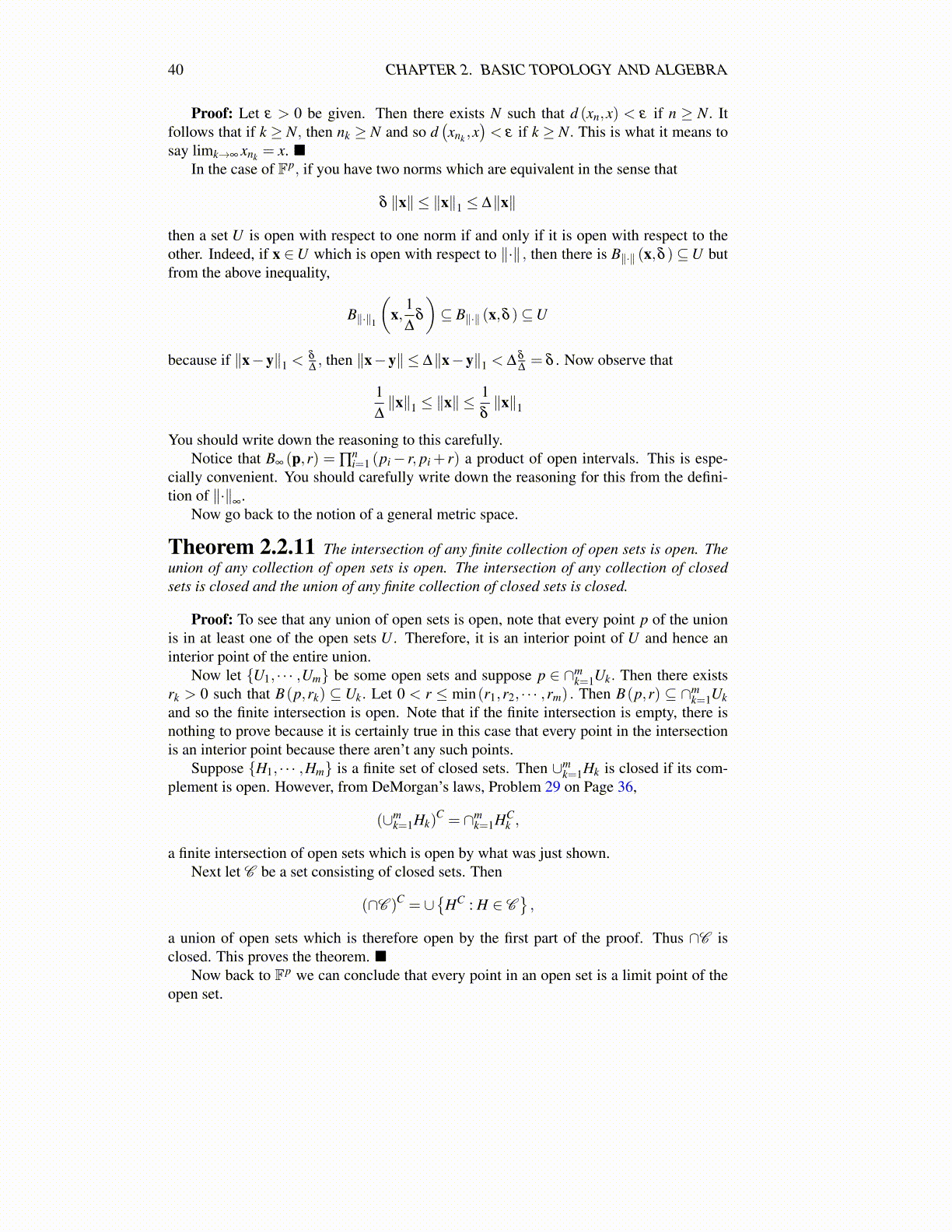
40 CHAPTER 2. BASIC TOPOLOGY AND ALGEBRA
Proof: Let ε > 0 be given. Then there exists N such that d (xn,x) < ε if n ≥ N. Itfollows that if k ≥ N, then nk ≥ N and so d
(xnk ,x
)< ε if k ≥ N. This is what it means to
say limk→∞ xnk = x. ■In the case of Fp, if you have two norms which are equivalent in the sense that
δ ∥x∥ ≤ ∥x∥1 ≤ ∆∥x∥
then a set U is open with respect to one norm if and only if it is open with respect to theother. Indeed, if x ∈U which is open with respect to ∥·∥ , then there is B∥·∥ (x,δ )⊆U butfrom the above inequality,
B∥·∥1
(x,
1∆
δ
)⊆ B∥·∥ (x,δ )⊆U
because if ∥x−y∥1 <δ
∆, then ∥x−y∥ ≤ ∆∥x−y∥1 < ∆
δ
∆= δ . Now observe that
1∆∥x∥1 ≤ ∥x∥ ≤
1δ∥x∥1
You should write down the reasoning to this carefully.Notice that B∞ (p,r) = ∏
ni=1 (pi− r, pi + r) a product of open intervals. This is espe-
cially convenient. You should carefully write down the reasoning for this from the defini-tion of ∥·∥
∞.
Now go back to the notion of a general metric space.
Theorem 2.2.11 The intersection of any finite collection of open sets is open. Theunion of any collection of open sets is open. The intersection of any collection of closedsets is closed and the union of any finite collection of closed sets is closed.
Proof: To see that any union of open sets is open, note that every point p of the unionis in at least one of the open sets U . Therefore, it is an interior point of U and hence aninterior point of the entire union.
Now let {U1, · · · ,Um} be some open sets and suppose p ∈ ∩mk=1Uk. Then there exists
rk > 0 such that B(p,rk) ⊆ Uk. Let 0 < r ≤ min(r1,r2, · · · ,rm) . Then B(p,r) ⊆ ∩mk=1Uk
and so the finite intersection is open. Note that if the finite intersection is empty, there isnothing to prove because it is certainly true in this case that every point in the intersectionis an interior point because there aren’t any such points.
Suppose {H1, · · · ,Hm} is a finite set of closed sets. Then ∪mk=1Hk is closed if its com-
plement is open. However, from DeMorgan’s laws, Problem 29 on Page 36,
(∪mk=1Hk)
C = ∩mk=1HC
k ,
a finite intersection of open sets which is open by what was just shown.Next let C be a set consisting of closed sets. Then
(∩C )C = ∪{
HC : H ∈ C},
a union of open sets which is therefore open by the first part of the proof. Thus ∩C isclosed. This proves the theorem. ■
Now back to Fp we can conclude that every point in an open set is a limit point of theopen set.